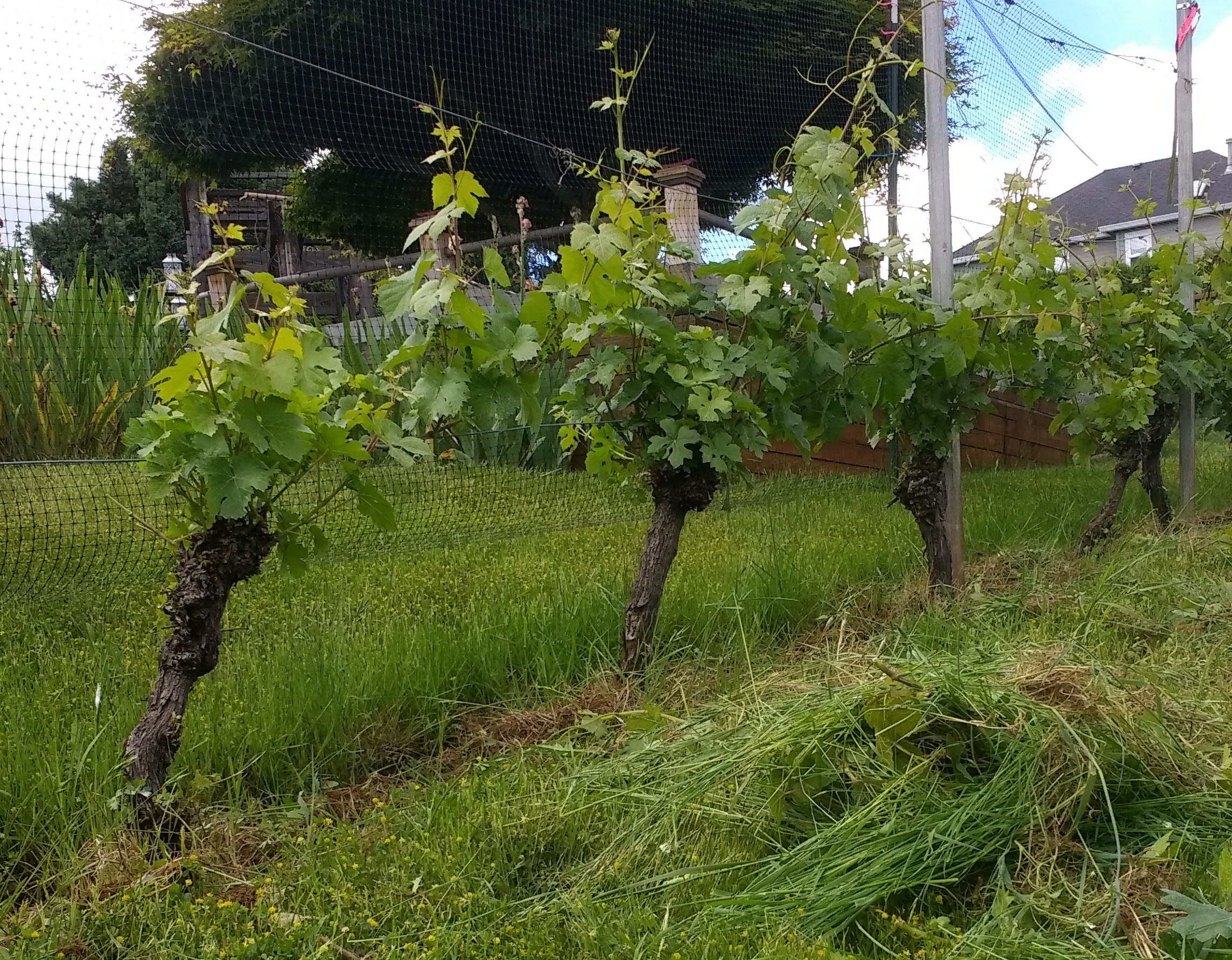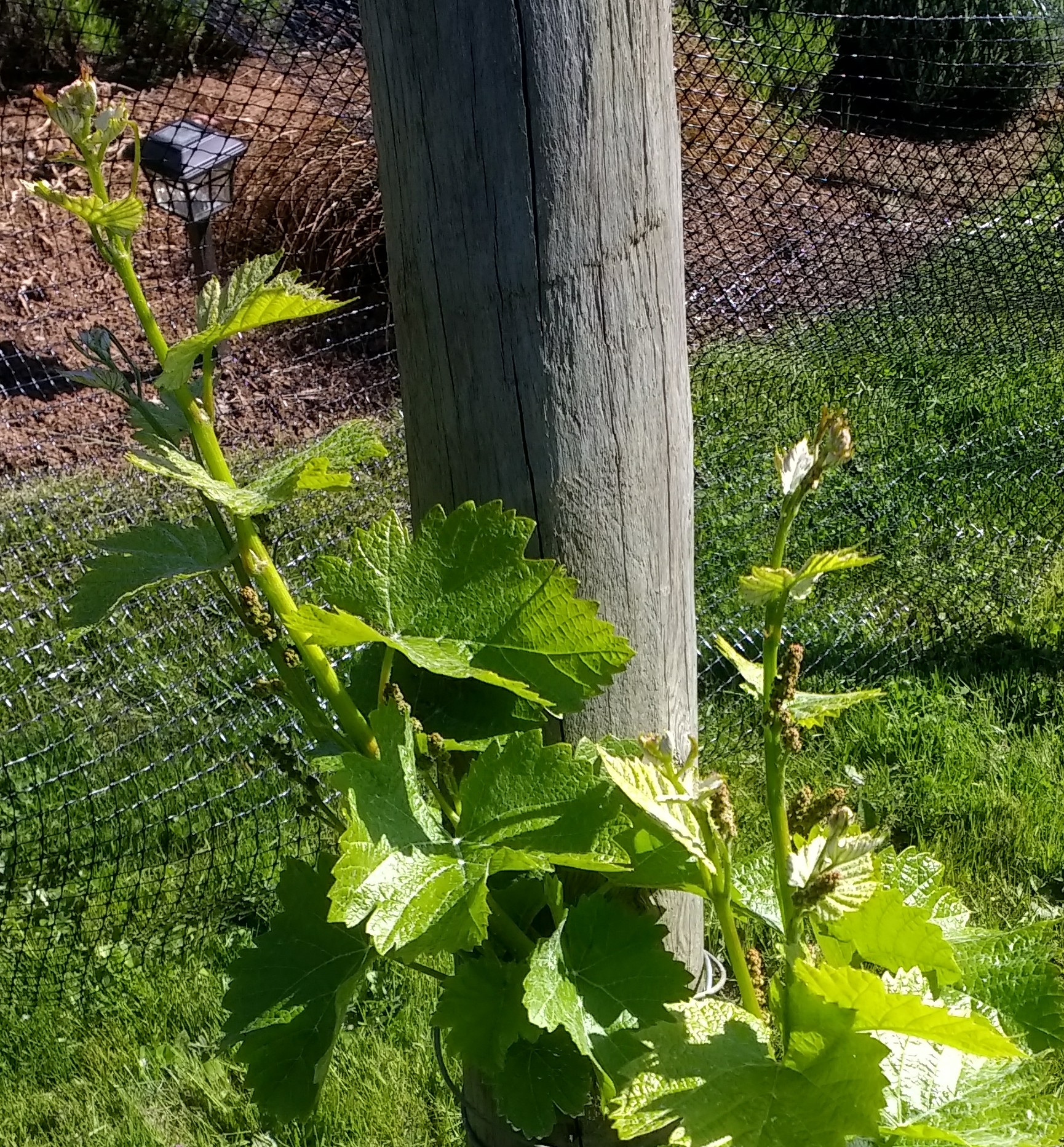Ask any wine maker and they will agree that great wine is made in the vineyard. Provided my plants escape all the perils that can befall Pinot Noir, powdery mildew, torrential rain, late frost, voracious deer, etc., the fruit is as good as any commercial vineyard.
In 1999, I planted 80 Pinot Noir plants in my Dundee backyard from cuttings obtained thanks to Jim & Loie Maresh. Most of them are Dijon 114 clones with about a dozen Wadenswil. The vineyard yield is about 15 gallons of finished wine or about 75 bottles. Every week or so through the season, I will post an update of the latest news.
September 8, 2020
Things are very ugly. Thousands of acres of PNW woods are ablaze and homes, barns and even small towns are threatened or worse. At first, clouds of smoke are so hot they fly by overhead like a malignant weather system, but it doesn’t take long before its filled in down to ground level. Activities are canceled due to smoke on top of cancellations due to covid. We get the guest room ready in case family or friends are evacuated.

September 7, 2020
We have an ominous forecast, east winds 20-30 mph with gusts to 50. Things are very dry and the forecast is for high fire risk.
I have a little sailboat in a slip on the Columbia river. Wind conditions there will be extreme so a trip to batten down the hatches is in order. The afternoon air is already smoky, but things are still. The windvane at the masthead points Northwest. Within a period of five minutes the vane swings east and quivers in the face of rapidly building wind. I’ve never seen such a rapid transition. Smoke pours in from the gorge. We’ve been warned things could get very ugly.
August 13, 2020
Veraison! When red grapes begin to turn color, its called veraison. When we get to this step, its time to breath a little easier. The fruit becomes a bit more mildew resistant and spraying can stop. Canopy growth slows so it feels like a downhill run to harvest. Of course, once the fruit is ripe, we’re going to need those days of easy living. You can’t go out for a coffee in the Willamette valley without running into bleary eyed wine makers and winery workers.
So far, so good!
July 19, 2020
Looks like we’re starting a long stretch of dry, warm weather. This is typical of Oregon summer and perfect for fruit development.
Vineyard chores settle into a routine of canopy management and spraying for mildew suppression. Canopy management consists of keeping vine growth tidy to allow for good air circulation and just a bit of sunlight penetration. Sun exposure is important to build sugar but too much sun can burn the fruit, which is then lost. As you can see from the pictures, canopy grows so fast, rows would grow together into a solid mass without trimming.
So far, so good!
July 8, 2020
 Summer 2020 weather continues cool and sometimes showery. Still, not a disaster. Canopy and fruit development are moving forward. When we get e good eighty degree day, it almost seems the vines grow before your very eyes. I’m going to test this theory the next time we get a hot day by creating a time lapse video. Just need the right weather to show up on set, then action!
Summer 2020 weather continues cool and sometimes showery. Still, not a disaster. Canopy and fruit development are moving forward. When we get e good eighty degree day, it almost seems the vines grow before your very eyes. I’m going to test this theory the next time we get a hot day by creating a time lapse video. Just need the right weather to show up on set, then action!
Looks like my backyard made it through the downpours that I worried would affect fruit set. The clusters look pretty good. Will keep an eye on that and post more pictures in a week or so.
 Work in the vineyard falls into a routine of trimming the vines into a hedge and opening (carefully) airways to reduce the mildew risk. With August a few weeks away, its not wise to open the canopy up too much and risk sunburn on the fruit. Will keep an eye on that too…
Work in the vineyard falls into a routine of trimming the vines into a hedge and opening (carefully) airways to reduce the mildew risk. With August a few weeks away, its not wise to open the canopy up too much and risk sunburn on the fruit. Will keep an eye on that too…
June 7 2020
 Good news and bad. Bloom has arrived. Ideally, a week or ten days of warm weather would settle over wine country and allow wind and bees to transport pollen between the tiny flowers opening on each cluster. The last few days have been perfect but this afternoon, showers and a few rumbles of thunder work down the valley.
Good news and bad. Bloom has arrived. Ideally, a week or ten days of warm weather would settle over wine country and allow wind and bees to transport pollen between the tiny flowers opening on each cluster. The last few days have been perfect but this afternoon, showers and a few rumbles of thunder work down the valley.
My vineyard has about 10-20% flowering. I’m hoping the big showers stay away.
When bloom happens is a complex interaction between vinifera type or clone, elevation and weather, primarily. i won’t go deep wine geek here, but, for example, my neighbor who also has a backyard vineyard just one year younger than mine, has already observed well advanced bloom. The difference is in our clones. He has Pommard 115 and I have Dijon 114. I also have one row of Wadenswil. This row has considerably more bloom than the Dijon rows.
This is what the flower of bloom looks like.

Incredibly tiny structure sprout from the proto-clusters, waiting for a kiss of pollen. Unless torrential rain interferes, they are not denied.
Want to learn the rest of this romantic story? We must walk (and drink) together….
June 1 2020
We’re in for a week of mild weather, sun and a high of about 70 degrees. Plants of every kind are growing so fast it seems they change almost minute by minute.
In the vineyard, canopy growth is mostly all up to the second wire. Typical pinot noir trellis is a wire system spanning about 4 vertical feet. A single bottom wire runs near the trunk head to secure the fruiting canes, another single wire about two feet above provides a mid way grip and two parallel wires two feet above that define the top of the canopy.

The next milestone in the fruit year is bloom. The clusters push out tiny flowers to receive pollen. Bloom happens over just a few days and dry weather during that time is critical. Heavy rain can cause clusters to be less than full and thus reduce fruit yield. This isn’t directly a quality problem but limits the farmers fruit management options if other weather problems arise later in the season.
More on that later…
May 26 2020
Confession; I am a lazy farmer. The Oregon pioneers considered the Willamette valley a modern Garden of Eden and its hard to disagree. Unfortunately, Eden takes a lot of maintenance!
The number one enemy of Pinot Noir grapes is powdery mildew. This stuff turns clusters of thin skinned grapes into nasty mush. Good air flow through the vineyard greatly mitigates this hazard, but it is a LOT of work.
.
Rows must be kept clear of grass and weeds. Each plant requires removal of the profusion of new shoots that burst forth during spring, limiting new growth to the head of the stalk and fruiting zone. Every plant must be carefully manicured. Keep in mind that one plant roughly equals one bottle of wine and you can imagine the enormous amount of labor needed.

May 8 2020
 We’re about three weeks from when the vineyard sprang back into life. Some fine weather and a few days of Oregon sunshine (rain) have things growing nicely. Many leaves are fully formed and tiny fruit clusters are numerous. Nice!
We’re about three weeks from when the vineyard sprang back into life. Some fine weather and a few days of Oregon sunshine (rain) have things growing nicely. Many leaves are fully formed and tiny fruit clusters are numerous. Nice!
